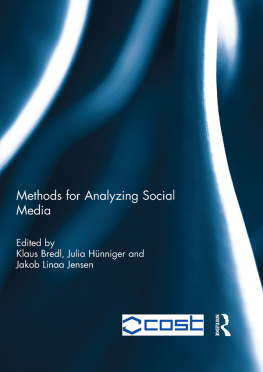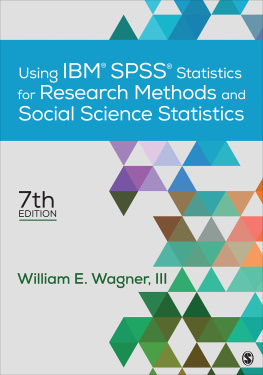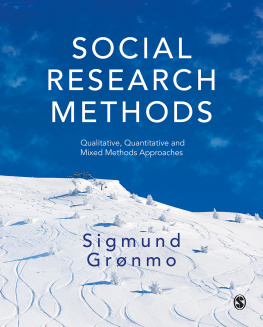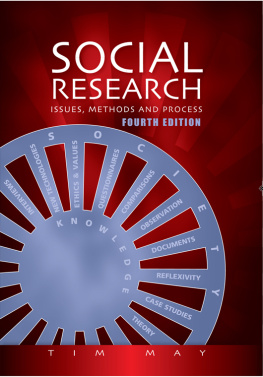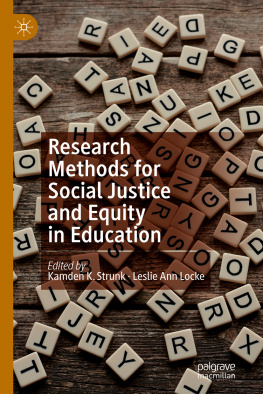Bailey - Methods of social research
Here you can read online Bailey - Methods of social research full text of the book (entire story) in english for free. Download pdf and epub, get meaning, cover and reviews about this ebook. City: New York, year: 1994, publisher: Free Press, Maxwell Macmillan Canada. Maxwell Macmillan International., New York, Toronto, genre: Politics. Description of the work, (preface) as well as reviews are available. Best literature library LitArk.com created for fans of good reading and offers a wide selection of genres:
Romance novel
Science fiction
Adventure
Detective
Science
History
Home and family
Prose
Art
Politics
Computer
Non-fiction
Religion
Business
Children
Humor
Choose a favorite category and find really read worthwhile books. Enjoy immersion in the world of imagination, feel the emotions of the characters or learn something new for yourself, make an fascinating discovery.

Methods of social research: summary, description and annotation
We offer to read an annotation, description, summary or preface (depends on what the author of the book "Methods of social research" wrote himself). If you haven't found the necessary information about the book — write in the comments, we will try to find it.
Bailey: author's other books
Who wrote Methods of social research? Find out the surname, the name of the author of the book and a list of all author's works by series.
Methods of social research — read online for free the complete book (whole text) full work
Below is the text of the book, divided by pages. System saving the place of the last page read, allows you to conveniently read the book "Methods of social research" online for free, without having to search again every time where you left off. Put a bookmark, and you can go to the page where you finished reading at any time.
Font size:
Interval:
Bookmark:
METHODS OF SOCIAL RESEARCH
KENNETH D. BAILEY
The Free Press
A Division of Macmillan, Inc.
New York
Maxwell Macmillan Canada, Inc.
1200 Eglinton Avenue East Suite 200 Don Mills,
Ontario M3C 3N1
Maxwell Macmillan International
NEW YORK OXFORD SINGAPORE SYDNEY
Copyright 1994 by The Free Press
All rights reserved. No part of this book may be reproduced or transmitted in any form or by any means, electronic or mechanical, including photocopying, recording, or by any information storage and retrieval system, without permission in writing from the Publisher.
The Free Press
A Division of Macmillan, Inc.
866 Third Avenue, New York, N. Y. 10022
www.SimonandSchuster.com
Maxwell Macmillan Canada, Inc.
1200 Eglinton Avenue East
Suite 200
Don Mills, Ontario M3C 3N1
Macmillan, Inc. is part of the Maxwell Communication Group of Companies.
Printed in the United States of America
printing number
1 2 3 4 5 6 7 8 9 10
Bailey, Kenneth D.
Methods of social research / Kenneth D. Bailey.4th ed.
p. cm.
Includes bibliographical references (p. ) and indexes.
ISBN 13: 978-0-0290-1279-6
ISBN 0-02-901279-1
eISBN-13: 978-1-43911-889-4
1. SociologyMethodology. I. Title.
HM24.B295 1994 93-36444
301.072dc20 CIP
To JNB and SJB
CONTENTS
The Unit of Analysis
Level of Measurement
Purposive Sampling
Pretesting
Approaching the Respondent
Two-Group Design
Measured Validity
13 Simulations and Games
Questions Format
Path Analysis
18 Ethics in Social Research
Ethics
It seems customary to preface a book on social research methods by stating that the book focuses on the interrelationship between theory and research. The implication seems to be that this will make it clear and easy to read. Unfortunately, things are not so simple. While not de-emphasizing the need to integrate theory and research, I have made it my major objective to write a book that is comprehensive and detailed enough to be useful while plainly written enough to be readable. Students are too often faced either with a book too simple to prepare them for the complexities of the real world of social research, with all its myriad problems, or too complex and abstract to be understood.
I have attempted to integrate the various data collection techniques by discussing the advantages and disadvantages and assessing the reliability and validity of each. I hope that this common framework will allow the student to compare methods more easily and will illuminate the compatibility of otherwise apparently diverse methods, thus dispelling the all too common but erroneous tendency to view the presentation of several methods in a single volume as a cafeteria approach having little continuity or depth.
The response from readers of the first three editions has been most gratifying, and I wish to thank all of you.
The chief goal in preparing the fourth edition is to move Methods of Social Research firmly into the 1990s. As before, this has meant diligent updating, reflecting steady progress in various areas. Once again, I had the impression of a maturing discipline, still growing, but now involved in refinement in a number of basic areas.
However, in addition to this steady growth and refinement, social research shows evidence of rather dramatic change in at least two areas. One is the growth of a number of new techniques, all new to this edition, and some spawned by technological developments. These include).
A second major development is the growing recognition that some groups are excluded from social research, and the development of methods for including them. The fourth and earlier editions deal with this problem in a number of chapters. For example, chapter 5 presents snowball sampling as a means of sampling excluded populations, while chapter 8 discusses the effects of race and sex of interviewers and respondents. In addition to such discussions, the fourth edition includes an entirely new chapter designed to study inclusion in a general fashion. This is chapter 17, Inclusionary Research Methods. This chapter deals with why such groups as women, racial and ethnic groups, alcoholics, homosexuals, the ill and disabled, and others are often excluded from research, and how they can be included.
I think that chapter 17 is a very important chapter. It obviously cannot deal with all groups, but it provides general guidelines for inclusion based on the available literature (which is mostly quite recent). This area will surely grow in importance and will receive increased attention as societies become more pluralistic during the 1990s and beyond.
A number of people worked especially hard in preparing this fourth edition. I wish to thank Leah Robin for reading the entire text and providing many helpful comments, and Charles OConnell for once again preparing the instructors manual. Special thanks also go to Joyce Seltzer, senior editor and vice president at The Free Press, for her excellent support at all stages of the project, and to Loretta Denner, Free Press production editor, for her excellent supervision.
We wish to thank the following for the use of their materials in the production of this book:
Patricia Breyer Wild for various questionnaire items, questionnaire portions, cover-letter portions, and descriptions of survey procedure from Child Health Care Survey (Los Angeles: University of California, 1973) and from Sociological Determinants of Utilization of a Prepaid Pediatric Health Care Plan (Ph.D. dissertation, University of California at Los Angeles, 1974 Patricia Breyer Wild). Reprinted by the permission of the author.
Gene N. Levine and Robert C. Rhodes for questionnaire items and introductory questionnaire statement from the Nisei Male Questionnaire Mailed Instrument (University of California at Los Angeles, Japanese-American Research Project [JARP] by Gene N. Levine and John Modell, 1967), which will be appearing in their forthcoming book, The Japanese-American Community. Reprinted by permission.
Leo G. Reeder for questionnaire items, opening statement, and face sheet from Student Survey: Questionnaire 1969a; The UCLA Student Poll 1969b; Los Angeles Metropolitan Area Survey: III (LAMAS III): Questionnaire 1971; and Los Angeles Metropolitan Area Survey: IV (LAMAS IV): Questionnaire 1972 by The Survey Research Center (SRC) of the University of California at Los Angeles. Reprinted by permission.
Marjorie N. Donald for material from Implications of Nonresponse for the Interpretation of Mail Questionnaire Data in Public Opinion Quarterly 24 (Spring): 102. Reprinted by the permission of the author and the publisher, 1960 American Association for Public Opinion Research.
John R. Raser for material from Simulation and Society: An Exploration of Scientific Gaming (Boston: Allyn and Bacon). Reprinted by the permission of the author, 1969 by John R. Raser.
Otis Dudley Duncan for material from Path Analysis: Sociological Examples in The American Journal of Sociology 72 (July). Reprinted by the permission of the author and the publisher, 1966 the University of Chicago. All rights reserved.
Robert Brown for material from Explanation in Social Science (Chicago: Aldine). Reprinted by the permission of Routledge and Kegan Paul, Ltd. and Aldine Publishing Co., 1963 Routledge and Kegan Paul, Ltd.

Font size:
Interval:
Bookmark:
Similar books «Methods of social research»
Look at similar books to Methods of social research. We have selected literature similar in name and meaning in the hope of providing readers with more options to find new, interesting, not yet read works.
Discussion, reviews of the book Methods of social research and just readers' own opinions. Leave your comments, write what you think about the work, its meaning or the main characters. Specify what exactly you liked and what you didn't like, and why you think so.







